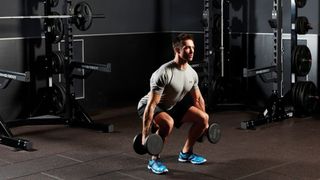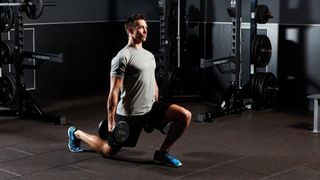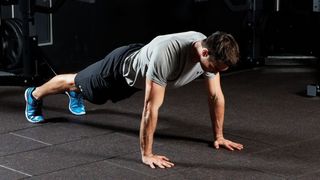Eight Workout Challenges To Test Your Mettle
Stuck in a training rut? Then try one of these eight gym challenges to put the fire back in your fitness belly

If you lift weights for a while, it’s likely that at some point you’ll feel like you’re stuck in a bit of a training rut. Your motivation will wane and your results will plateau. And when that happens, instead of throwing in the sandpaper-esque complimentary gym towel, we suggest that you turn to one of these workouts. They’re designed to offer a new physical and mental challenge – something for you to focus on that will rekindle your love affair with working up a sweat. Each one is designed to be done as a standalone workout, so you can try one of them or attempt a few in different sessions.
For each one we’ve given you a sample session that you can try, but you can also invent your own routines that fit into the different training modalities. So, for example, if you do an inverse ladder we’ve suggested that you try press-ups and jump squats, but you could do pull-ups and dips.
You’ll also find that these sessions provide a great mental challenge. They’ve been cleverly designed to be manageable but tough, so you’ll have to battle through psychological as well as physical obstacles. But your new-found work capacity and mental toughness will stand you in good stead to get back to your normal routine feeling fitter and stronger than ever.
Centurion
In this session your aim is simple: select three moves and complete 100 reps of each of them as fast as you can, any way you like. You could try to do as many reps as possible of one move in one set and complete the 100 reps in as few sets as possible, or you could break it down into manageable chunks such as doing ten sets of ten reps of each. It really is up to you.
The theory
This session pits your body and mind against the clock. It’s a good old-fashioned grind designed to test you to your limits. The most sensible approach is to break each exercise down into 20- to 25-rep sets. You’ll need to select a move and a load that allows you to complete the 100 reps in four to five sets. Fewer and it’s too light. More and it’s too heavy.
The challenge

- Dumbbell squat
- Dumbbell curl
- Dumbbell press
This involves three moves that, between them, work most major muscle groups. To make it easy you can use the same weight of dumbbell for each move but to make it a higher-quality workout, choose a heavier load for the squats than the curls.
Expert tip Whenever you do the Centurion, time how long it takes and aim to beat that time the next time you complete the challenge.
Get the Coach Newsletter
Sign up for workout ideas, training advice, reviews of the latest gear and more.
EMOM
EMOM stands for every minute on the minute and involves you performing a set amount of work at the start of each minute of your workout. It’s a versatile way to train – beginners can select one move and do, say, ten reps of that exercise. More advanced exercisers can attempt two moves, which will leave less rest time each minute and provide a tougher fitness test.
The theory
EMOMs can be tough but they also tend to fly by, which is great if you want a quick workout. They usually start out feeling fairly comfortable but get tougher the longer you go on because the rep count stays the same as you tire. It’s also likely that you’ll have less and less rest each minute because the accumulated fatigue means it takes longer to do the work.
The challenge

We’ve gone for a two-move EMOM, and to keep things simple you do ten reps of both move, then rest until the start of the next minute. That means you can clock up 100 reps of each move in under ten minutes. Just adjust the variables to suit your ability.
One-Move Challenge
This workout is a test of your mental strength as much as your physical capacity. It’s pretty simple: you pick a single move and an ambitious number of reps, and you aim to complete them as quickly as possible. You can also pick a single move and a set time and rack up as many reps as you can in the allotted time. But be warned – it’s a brutal session.
The theory
The idea is to pick a compound move like a lunge or a burpee, and if you do you’ll work a lot of muscles as well as tax your cardio system. You could try as many burpees as you can in a minute, or you could see how long it takes you to do 500 lunges. It’ll develop your ability to tolerate lactic acid (which builds up in your muscles during exercise, causing pain).
The challenge: Burpee
No-one really likes burpees – but they are a fantastic move because they work so many muscle groups and you can do them anywhere. How many reps you go for or how long your session lasts should depend on your fitness level. Whatever stage you’re at, record your performance and try to beat it the next time you do it.
AMRAP
AMRAP stands for as many rounds (or reps) as possible, and it involves completing as much work as you can in a set time or at a set weight. For fat loss, doing as many rounds as you can is a good option because you don’t need heavy loads to make it challenging. Just pick your exercises, set a clock and take a deep breath because rest will be in short supply.
The theory
The aim is to do the maximum amount of work your body is able to complete, so this is a tough test of fitness. You also get very little rest so it challenges your ability to complete long periods of work. Depending on the moves you select, a workout duration of ten to 20 minutes should work well. It also makes sense to select compound moves rather than isolation ones.
The challenge
This is an excellent example of a barbell circuit because it works virtually every major muscle group. Do as many rounds of ten reps of each exercise in a row as you can in 15 minutes. Use a load that’s appropriate for your level.
Expert tip When creating an AMRAP challenge, use compound (multi-joint) moves because they give you a bigger cardio test than isolation (single-joint) exercises.
Ladder
A ladder is a workout in which you add a rep each set. The simplest way of doing it is to pick one exercise and start at one rep for the first set, then do two for the second, three for the third and so on. How high your ladder goes is up to you. You can also decide to start on, say, five reps, if it’s a relatively easy move, and you can also select how long your rest period is.
The theory
It’s simple and flexible and can be used to do most exercises. For the purposes of fat loss, it makes sense to select a compound move (one that works multiple muscle groups) that is reasonably challenging. You could do a crunch but it would be quite boring and it wouldn’t burn many calories or use that many muscles. A press-up is a better option.
The challenge: Press-up

If you decide to do press-ups, make sure your reps are slow and controlled. That will recruit the maximum number of muscle fibres and help ensure that you do the move with perfect form. You can do a ladder workout with two moves but, if you decide to do that, you may prefer to do the next option.
Inverse Ladder
An inverse ladder is a workout that involves doing two exercises. In the first round you do a single rep of one move and then, say, ten reps of another move. In the next round you do two reps of the first move and nine reps of the second. You continue that pattern until you have completed a round in which you do ten reps of the first move and one of the second.
The theory
Single-exercise ladder sessions can be a bit dull, so this is a way of making a ladder workout more interesting. It is also an excellent way of pairing an upper-body move with a lower-body move. Doing that will keep your heart rate high throughout the session but your muscles still get a chance to recover. Our advice: do ten reps of the harder move in the first round.
The challenge

This is a fantastic little workout that takes only about 15 minutes to complete. Do one press-up, then ten jump squats, then rest for 30 seconds. Continue to use the inverse ladder system until you have completed a round of ten press-ups and one jump squat.
6, 12, 25
This workout was popularised by the renowned strength coach Charles Poliquin and involves doing six reps of one exercise, 12 reps of another and 25 of a third back to back with little or no rest. It can be used as a muscle-building protocol as well as a fat loss tool, and the length of rest between rounds will dictate which is the focus – less rest means more fat burning.
The theory
When this is used as a bodybuilding protocol, the three exercises usually work the same body part to cause complete fatigue. For fat loss, though, the exercises don’t have to target the same body part but should be chosen to give you a rep count that’s taxing. The aim is to create a mixture of cardiovascular and muscular fatigue.
The challenge
- Incline bench press
- Incline dumbbell bench press
- Dumbbell flye
All the exercises in this workout target your chest. You start with a heavy barbell move, then do a dumbbell version. The final move is a lighter exercise but the high rep count will make it taxing. Complete five rounds in total with 90 seconds’ rest between rounds.
Expert tip When doing 6, 12, 25, always put the exercise that involves the heaviest weight first and the move that involves the lightest weight last.
Body Part Bash
This is an advanced session because it uses multiple exercises that primarily target the same body part. Choose between two and four exercises, starting with the most difficult or the heaviest move. Do the moves with minimal or even rest.
The theory
This is not for beginners because the body part you’re targeting doesn’t get any rest. In a lot of workouts the exercises often alternate between upper- and lower-body moves or antagonistic muscles, which means that one muscle group can recover while another works. But in this instance, you don’t get any rest, which means that you improve your ability to deal with lactic acid.
The challenge

This four-move workout will thrash your shoulders. Aim to do ten reps of each exercise in order without resting. Rest for 60-90 seconds at the end of the round and complete three to five rounds, depending on your stamina.
More Fitness Challenges

Joe Warner is a highly experienced journalist and editor who began working in fitness media in 2008. He has featured on the cover of Men’s Fitness UK twice and has co-authored Amazon best-sellers including 12-Week Body Plan. He was the editor of Men’s Fitness UK magazine between 2016 and 2019, when that title shared a website with Coach.
